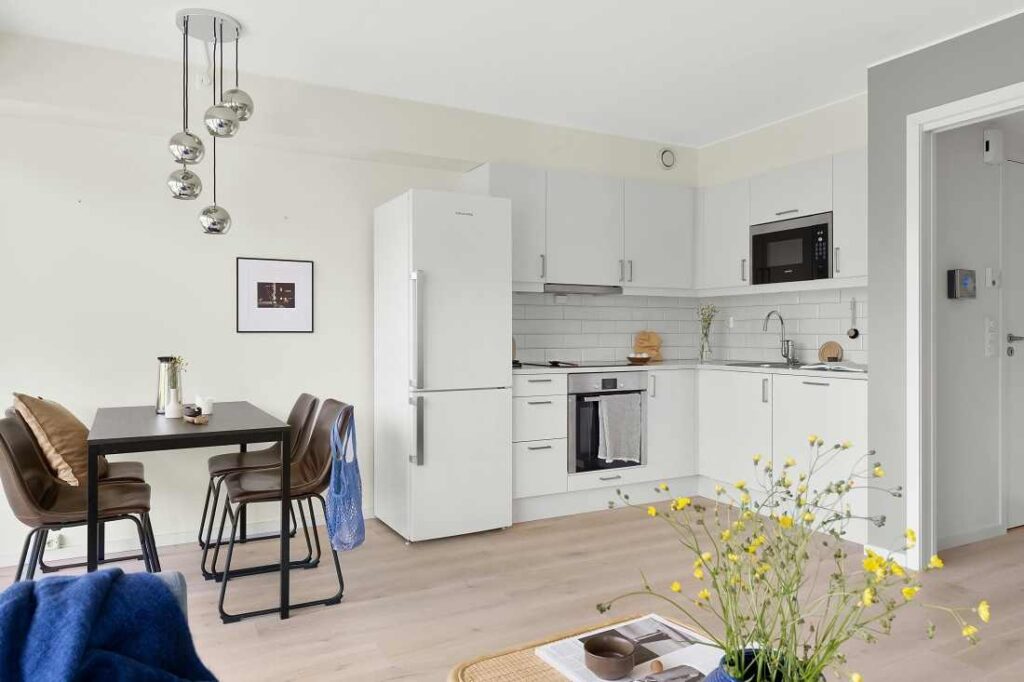
Studio apartments are characterized by a single, open space that combines the living room, bedroom, and kitchen into one area. The bathroom is typically the only separate room.
Living in a studio apartment can be a unique and rewarding experience, though it comes with its own set of challenges and benefits.

Benefits of studio apartments:

Financial Benefits
- Lower Rent:
- Studio apartments generally have lower rent compared to larger apartments, making them a cost-effective option for singles, students, or anyone on a budget.
- Reduced Utility Costs:
- With a smaller space, heating, cooling, and electricity bills are typically lower, helping to save on monthly expenses.
Efficient Living
- Less Cleaning and Maintenance:
- The smaller size of a studio means there’s less space to clean and maintain, which can save time and effort.
- Encourages Minimalism:
- Living in a studio often encourages a minimalist lifestyle, as the limited space necessitates keeping only essential items and avoiding clutter.
Location and Convenience
- Prime Locations:
- Studio apartments are often available in central urban areas, providing easy access to amenities, public transportation, workplaces, and entertainment venues.
- Urban Living:
- Living in a studio often means being close to the heart of the city, offering a vibrant lifestyle with plenty of opportunities for socializing and activities.
Comfort and Coziness
- Intimate Space:
- The compact nature of a studio apartment can create a cozy, intimate environment that feels snug and personal.
- Easier to Personalize:
- With a smaller space, decorating and personalizing your living area is more manageable and can make the apartment feel uniquely yours.
Practicality and Flexibility
- Efficient Use of Space:
- Studio apartments often feature open-plan layouts, allowing for versatile and flexible use of space that can be adapted to your needs.
- Simplified Living:
- The simplicity of a studio apartment can streamline daily life, making it easier to manage and reducing the stress associated with larger living spaces.
Social and Environmental Benefits
- Environmentally Friendly:
- Smaller living spaces typically have a smaller environmental footprint, requiring less energy for heating, cooling, and lighting.
- Sense of Community:
- Many studio apartments are located in buildings with shared amenities and communal spaces, fostering a sense of community among residents.
Adaptability
- Ideal for Singles and Couples:
- Studio apartments are perfect for single individuals or couples who don’t require a lot of space and appreciate a more compact living arrangement.
- Great for Temporary Living:
- Studios can be an excellent choice for temporary living situations, such as short-term work assignments, or internships, or as a stepping stone before moving to a larger space.
Cost-Effective Furnishing
- Less Furniture Needed:
- Furnishing a studio apartment can be more affordable since you need fewer pieces of furniture and decor to fill the space.
- Multifunctional Furniture:
- Investing in multifunctional furniture, such as sofa beds, fold-out tables, and storage ottomans, can maximize space efficiency and functionality.
Enhanced Focus and Productivity
- Cozy Workspaces:
- The intimate setting of a studio can be conducive to focused work or study, creating a cozy nook for productivity.
- Easier to Organize:
- With everything in one space, it’s easier to keep track of belongings and maintain an organized environment.

Challenges that come with living in a studio apartment:
Space Constraints
- Limited Space:
- Single Room: The living, sleeping, and often dining areas are all combined into one space, which can feel cramped, especially if not well-organized.
- Storage: Finding enough storage for clothes, kitchen items, and personal belongings can be difficult. Creative storage solutions are often necessary.
- Furniture Arrangement:
- Multifunctional Furniture: You need to invest in multifunctional or space-saving furniture, which can sometimes be more expensive or less comfortable.
- Layout Challenges: Arranging furniture to create distinct living areas (e.g., a separate sleeping area) can be tricky.
Privacy Issues
- Lack of Separation:
- Single Space: There’s no separate bedroom, making it difficult to have private time or space away from guests or partners.
- Work-Life Balance: If you work from home, it can be challenging to create a distinction between work and personal life.
- Entertaining Guests:
- Limited Space for Guests: Hosting parties or having overnight guests can be difficult due to the limited space and lack of privacy.
Noise and Distractions
- Combined Spaces:
- Noise Control: With all activities happening in one room, it can be hard to control noise. For instance, watching TV might disturb someone sleeping.
- Distractions: The lack of separate spaces can make it hard to focus on tasks, especially if you have multiple activities happening at once.
Lifestyle Adjustments
- Minimalist Lifestyle:
- Decluttering: Regular decluttering is essential to prevent the space from feeling cluttered and cramped.
- Essential Items Only: You may need to adopt a minimalist lifestyle, keeping only essential items and frequently used belongings.
- Daily Routines:
- Cooking Odors: Cooking smells can easily spread to the living and sleeping areas, which might be unpleasant.
- Laundry and Cleaning: Managing laundry and cleaning routines in a small space can be challenging, especially if you don’t have in-unit laundry facilities.
Aesthetic and Comfort Concerns
- Decorating Limitations:
- Limited Space for Decor: There is less room for decorative items, and every piece of furniture needs to be carefully chosen for functionality.
- Personalization: It can be harder to personalize the space without making it feel cluttered.
- Comfort Issues:
- Multifunctional Spaces: Using the same space for different activities (e.g., working, relaxing, sleeping) can sometimes compromise comfort.
Practical Concerns
- Higher Per Square Foot Cost:
- Rent and Utilities: Although overall rent might be lower, the cost per square foot can be higher compared to larger apartments.
- Resale and Rental Market:
- Market Demand: In some markets, studio apartments may be less in demand compared to one-bedroom units, potentially affecting resale value or ease of finding new tenants.
Mental and Emotional Impact
- Feeling Confined:
- Limited Space: The small size can sometimes lead to feelings of confinement or claustrophobia, especially if you spend a lot of time at home.
- Mental Health: The lack of distinct areas for different activities can impact mental health, making it harder to relax or feel productive.
- Social Isolation:
- Entertaining Constraints: Limited space for socializing can lead to feelings of isolation or loneliness, as you might be less inclined to invite friends over.


